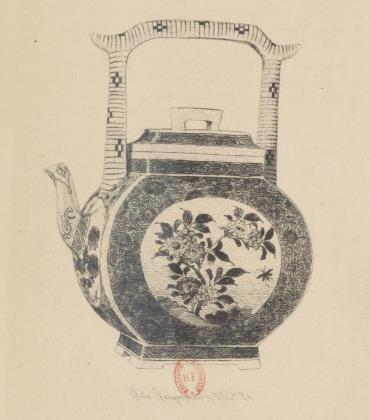
BARBET de JOUY Henry (EN)
Biographical article
Joseph-Henri Barbet de Jouy (1812-1896), who was an archaeologist, art historian, and curator, spent most of his career at the Musée du Louvre, which he joined in 1851 following the bankruptcy of his father's business. He is known for his numerous catalogues of the Louvre’s collections and his actions to protect the museum during the Commune in 1870. A critical article about him was written by Geneviève Bresc-Bautier as part of the Dictionnaire des historiens d’art published by the Institut national d’Histoire de l’art, which we recommend to readers. The present articlefocuses on his activities as a collector.

The collection
A "Fatal Gift"
In his preface to the Barbet de Jouy sales catalogue, Charles Éphrussi (1849-1905) gives an astonishing portrait of this collector. At twelve years old, the young Joseph Henri received a "Chinese vase" from his grandmother that forever sealed his destiny as a collector (Ephrussi, 1879, p. IIV-IV). This "fatal gift from an imprudent grandmother" led him to acquire Chinese porcelain relentlessly, from dealers in curiosities as well as at major auctions. His collection of objects thus seems to have little connection with his studies as an art historian and curator at the Louvre (see bibliography, and Bresc-Bautier G., 2016).
Prestigious Sources
In the absence of a posthumous inventory, the 1879 sales catalogue is the sole means of accounting for what was once the Barbet de Jouy collection (Lugt 39109). It included nearly 200 Chinese porcelains (195 lots) and 20 Japanese porcelains (lots 196 to 217), in addition to several oriental rugs. The numbers 242 to 245, which close the sale, correspond to the collector's display cases.
The sale catalogue, written by Musée des Arts décoratifs curator Paul Gasnault (1828-1898), lists a large number of prestigious provenances, with more than 40 works from the sales of the Duchess of Montebello in 1857. A real turning point in the world of curiosities, the posthumous sales of Louise Antoinette Scholastique Guéheneux Maréchale de Lannes duchesse de Montebello (1782-1856; Lugt 23338, 23368, 23407, 23417, 23441, 23493, 23507) were famous for their collection of works from China and from Japan. The sales of the Duchesse de Berry (1865, Lugt 28508), Baron Hyppolyte Boissel de Monville (1866, Lugt 28856), Augustin Pierre Daigremont (1861, Lugt 26072), Jean Achille Deville (1858, Lugt 24138), Charles de Férol (written "Ferrol" in the catalog, 1863, Lugt 27187), Louis Fould (1860, Lugt 25635), Humann (1858, Lugt 23977), Lablache (1858, Lugt 24224), du duc de Morny (1865, Lugt 28746), de Poinsot (1861, Lugt 26033), de James-Alexandre de Pourtalès-Gorgier (1865), du prince Soltykov (written "Soltikoff" in the catalog), Juste (1868, Lugt 30184), Viscount Paul Daru (1867, Lugt, 29527), Elisabeth Rachel Félix, known as Miss Rachel (1857, Lugt 23743), Marks (1863, Lugt 27378 and 1864, Lugt 28135) are also mentioned. Moreover, several pieces in his catalogue are indicated as coming from the Summer Palace, the Yuanmingyuan 圓明園, the palatial residence of the Manchurian emperors that was looted and then burned by Franco-British troops in 1860.
The Tale of a Teapot
Surprisingly, the works from the Summer Palace did not obtain the highest prices at this sale, contrary to what one might have expected given the prestige and imperial character of their provenance (d'Abrigeon P., 2019). This is evidenced by a famille verte teapot enamelled on biscuit from the Kangxi 康熙period (1662-1722), which went for the staggering sum of 1,305Francs (lot 126; see illustration in this notice), whereas, in the same sale, a teapot bearing an imperial mark Qianlong 乾隆 (1736-1795) and sold as coming from the Yuanmingyuan came in at only 155F (lot 130; AP, D48E3 68). How to explain this disparity? It is likely that the pedigree of the 1,305 Franc teapot was more important in the history of Chinese porcelain collections in France: engraved in 1875 in the Histoire de la Céramique by Albert Jacquemart (1808-1875), a critic of famous and esteemed art, inventor of the nomenclature of "families" (cf. notice Albert Jacquemart), it was also present at the aforementioned sale of the curator of Rouen’s museum of antiquities, Jean Achille Deville, in 1858. Although stylistically posterior, the piece was dated by Albert Jacquemart to the Xuande period (1426-1435), referring to the date stamped under the base (da Ming Xuande nian zhi大明宣德年製). The piece’s age may also have played a role in its valuation.
Colourful Paintings
Unlike other collectors of his time who built up scientific collections and even accepted a damaged object if it represented a sample of interest (cf. Albert Jacquemart notice), Barbet de Jouy seems to have developed a more aesthetic, even purist approach to collecting, leaving little room for incompleteness. Charles Éphrussi shares a delightful anecdote on this topic: after buying a pair of vases from the Qianlong period (1736-1795), one of which was restored, he finished off the restored vase by breaking it on the spot, as much to render the remaining vase unique as to get rid of a mutilated vase which "had shocked his delicate eye" (Ephrussi, 1879, p. V). Barbet de Jouy also paid particular attention to the presentation of his collection in his display cases, composed, according to Charles Ephrussi, like veritable coloured paintings (Ephrussi, 1879, p. VI).
The extremely specialised character of the collection seems to indicate this more aesthetic approach, rendering this collector a rather singular case.
Related articles
Collection / collection d'une personne
Personne / personne



